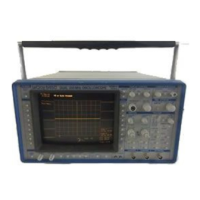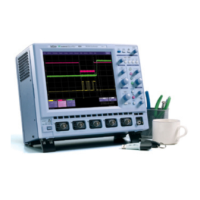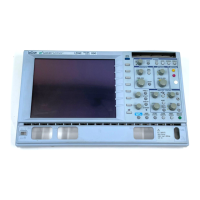GPIB Operation
|
|
ADDRESSING
GPIB SIGNALS
Data Lines
Handshake Lines
Interface Management Lines
12
Every device on the GPIB has an address. When the thumbwheel
address switches on the rear panel of the oscilloscope are set to a
value between 0 and 30, the instrument can be controlled via
GPIB. When the switches are set to above 30, the instrument can
execute talk-only operations on the GPIB, for example driving a
GPIB plotter. In this case no controller is present and the instru-
ment is directly connected to the plotter. Addresses above 30 also
enable the instrument to be controlled via the RS-232-C port.
The instrument reads the address switches once at power on, or
when the RESET button on the rear panel is pressed. If the ad-
dress is changed during operation, the instrument must be
powered again to enable the new address. The value of the GPIB
address appears in the menu "Auxiliary Setups".
If the oscilloscope is addressed to talk, it will remain configured to
talk until a universal untalk command (UNT), its own listen ad-
dress (MLA), or another instrument’s talk address is received.
Similarly, if the oscilloscope is addressed to listen, it will remain
configured to listen until a universal unlisten command (UNL),
its own talker address (MTA) is received.
The bus system consists of 16 signal lines and 8 ground or shield
lines. The signal lines are divided into 3 groups:
¯
8 data lines
¯
3 handshake lines
¯
5 interface management lines
The eight data lines, usually called DI01 through DI08, carry both
program and interface messages. Most of the messages use the
7-bit ASCII code, in which case DI08 is unused.
These three lines control the transfer of message bytes between
devices. The process is called a three-wire interlocked handshake
and it guarantees that the message bytes on the data lines are sent
and received without transmission error.
The following five lines manage the flow of information across the
interface.
ATN (ATteNtion): The controller drives the ATN line true when
it uses the data lines to send interface messages such as talk and
listen addresses or a device clear (DCL) message. When ATN
false, the bus is in the data mode for the transfer of program mes-
sages from talkers to listeners.
IFC (InterFace Clear): The controller sets the IFC line true
initialize the bus.
II
n
i
l
l
l
II
II
II
II
II
n
II
g
g
II

